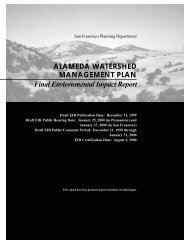Feasibility of Fish Passage at Alameda Creek Diversion Dam
Feasibility of Fish Passage at Alameda Creek Diversion Dam
Feasibility of Fish Passage at Alameda Creek Diversion Dam
Create successful ePaper yourself
Turn your PDF publications into a flip-book with our unique Google optimized e-Paper software.
<strong>Feasibility</strong> <strong>of</strong> <strong>Fish</strong> <strong>Passage</strong> <strong>at</strong> <strong>Alameda</strong> <strong>Creek</strong> <strong>Diversion</strong> <strong>Dam</strong>■■Installing a screen system in the sediment channel behind the existing trash rack.Constructing a new screen structure outside <strong>of</strong> the sediment channel in front <strong>of</strong> the existingstructure, and reusing the found<strong>at</strong>ion <strong>of</strong> the existing trash rack or replacing it altogether.The feasibility <strong>of</strong> each loc<strong>at</strong>ion listed above is evalu<strong>at</strong>ed based upon corresponding physical andtechnical constraints and fish screen design criteria.Each configur<strong>at</strong>ion has its own advantages and disadvantages, both in terms <strong>of</strong> cost <strong>of</strong>implement<strong>at</strong>ion and maximum allowable diversion r<strong>at</strong>es. All <strong>of</strong> the design configur<strong>at</strong>ions will requirea fish bypass flow estim<strong>at</strong>ed <strong>at</strong> 5 cfs, which will return flow to <strong>Alameda</strong> <strong>Creek</strong> downstream <strong>of</strong> thefacility, and a power source for oper<strong>at</strong>ion <strong>of</strong> the required autom<strong>at</strong>ic cleaning mechanism.SCREEN SYSTEM IN THE SEDIMENT CHANNELThis configur<strong>at</strong>ion involves the placement <strong>of</strong> a fish screen in the sediment channel as shown inFigure 4-13. The maximum amount <strong>of</strong> allowable diversion is a function <strong>of</strong> approach velocity andscreen area. A minimum screen area <strong>of</strong> 1,600 square feet would be required to maintain the existingdiversion capacity <strong>of</strong> the ACDT. Install<strong>at</strong>ion <strong>of</strong> the screen behind the existing trash rack, dependingon the angle <strong>of</strong> incline or angle <strong>of</strong> orient<strong>at</strong>ion with the diversion channel (skew) <strong>at</strong> which the screen isplaced, would likely limit screen area to approxim<strong>at</strong>ely 1,000 square feet because much <strong>of</strong> the surfacearea is composed <strong>of</strong> beams and the existing walks. At 1,000 square feet, diversion capacity wouldlikely be limited to a maximum <strong>of</strong> 260 cfs. The effective screen area may be increased by placing thescreens <strong>at</strong> an incline; a gre<strong>at</strong>er exagger<strong>at</strong>ion <strong>of</strong> the skew and incline results in gre<strong>at</strong>er effective surfacearea <strong>of</strong> the screen. However, it may decrease the uniformity <strong>of</strong> the flow velocity passing through thescreen, and flow uniformity is one <strong>of</strong> the screen criteria regul<strong>at</strong>ed by NMFS (2008). Thisconfigur<strong>at</strong>ion would require a new steel support structure, a walkway on top <strong>of</strong> the screen, baffleguides and baffle assembly, fl<strong>at</strong>-pl<strong>at</strong>e screen panes, and install<strong>at</strong>ion <strong>of</strong> a fish screen bypass.A fish screen bypass via a notch in the crest <strong>of</strong> the dam was evalu<strong>at</strong>ed, but is rejected from furtherconsider<strong>at</strong>ion. In order to pass w<strong>at</strong>er <strong>at</strong> all levels <strong>of</strong> diversion, the notch would have to extend fromthe dam crest to below the invert <strong>of</strong> the worker access tunnel within ACDD, which is a verticaldistance <strong>of</strong> approxim<strong>at</strong>ely 15 feet. This was determined to be an unacceptable solution because (1) alarge hollow gallery in the dam th<strong>at</strong> provides access to the left side <strong>of</strong> the dam would be blocked bysuch a notch, (2) the engineering challenges associ<strong>at</strong>ed with preventing w<strong>at</strong>er from bypassing thediversion through the notch <strong>at</strong> high flows would be significant, and (3) the structural integrity <strong>of</strong> thedam could be compromised by such a notch. A fish screen bypass through the gravity wall <strong>of</strong> thesediment channel was determined to be a better solution.The fish screen bypass could be configured as a tunnel through the gravity wall. Open channel flowis typically required to protect fish in the bypass from injury. It may be possible to modify thepreviously designed CDRP-proposed stream flow bypass tunnel for use as the fish screen bypasstunnel. In order to limit the fish screen bypass flows to 5 cfs, and to maintain an open channel in thebypass th<strong>at</strong> would provide safe passage for fish, a concrete control structure could be installed <strong>at</strong> thescreen exit to accommod<strong>at</strong>e a range <strong>of</strong> w<strong>at</strong>er elev<strong>at</strong>ions. The control structure could potentially bedesigned to accommod<strong>at</strong>e w<strong>at</strong>er and fish from several openings <strong>at</strong> different elev<strong>at</strong>ions, therebyfunctioning for a variety <strong>of</strong> w<strong>at</strong>er surface elev<strong>at</strong>ions. Further analysis <strong>of</strong> the fish bypass would needto be developed upon design.ACDD <strong>Passage</strong> June 2009 Page 4-22








